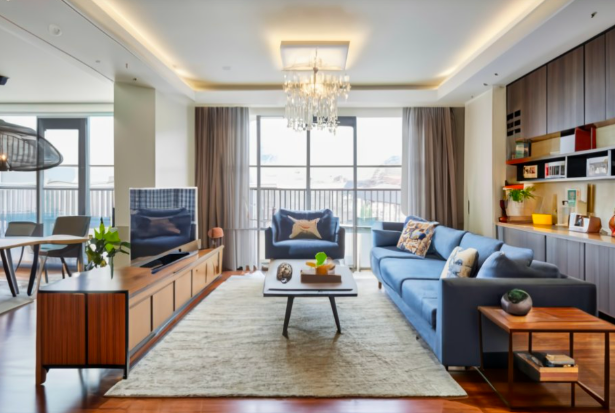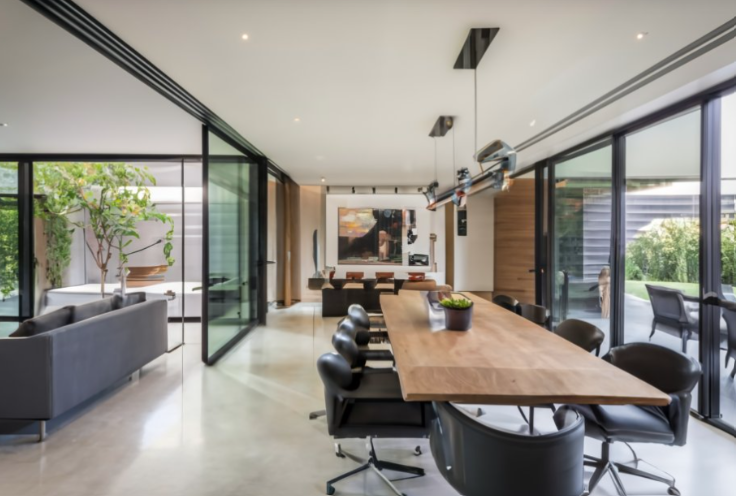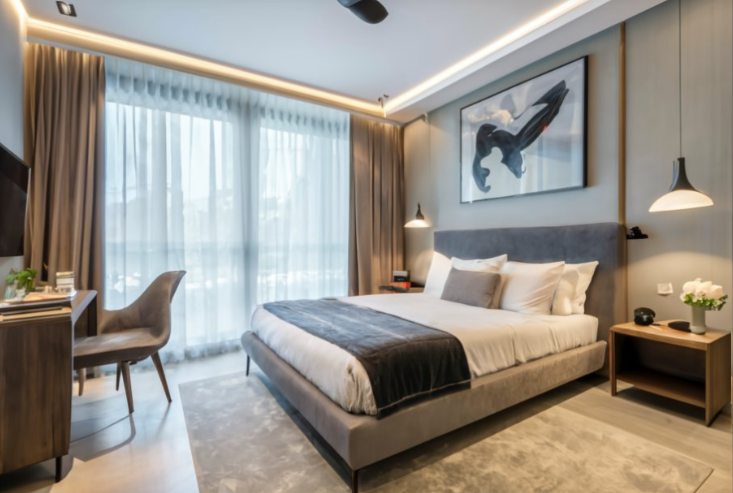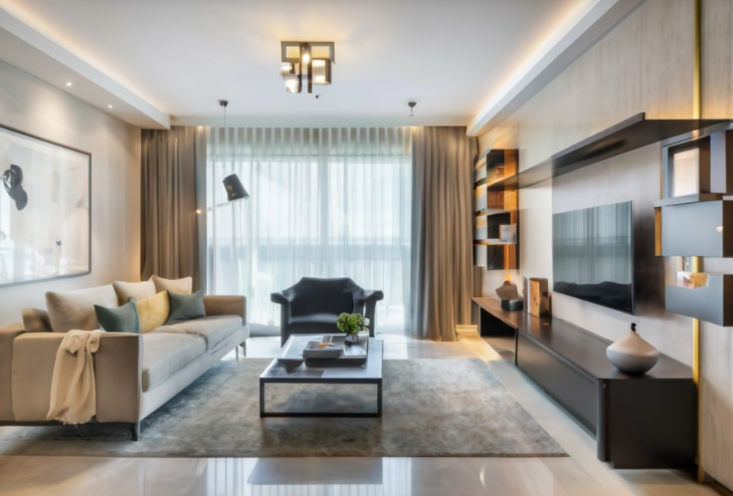Unveiling Harmony: A Guide to Color Schemes for Living Rooms
The living room: a haven for relaxation, entertainment, and creating memories with loved ones. But an empty space doesn't translate to a warm and inviting living room. This is where color comes in, playing a pivotal role in setting the mood, defining the space, and reflecting your unique personality. Choosing the right color scheme for your living room can be both exciting and daunting. This comprehensive guide delves into the world of color schemes, empowering you to create a harmonious and stylish living space that reflects your taste. The Science Behind the Palette: Understanding Color Theory Before diving into specific color schemes, understanding the basic principles of color theory is crucial. It's the language through which colors communicate and interact with each other. A. The Primary Colors: The foundation of color theory lies in the three primary colors: red, yellow, and blue. These colors cannot be created by mixing other colors, but when combined in various proportions, they create a vast spectrum of new hues. B. Secondary Colors: Mixing primary colors in equal parts results in secondary colors: orange (red + yellow), green (blue + yellow), and violet (red + blue). These secondary colors, along with the primaries, form the six basic colors. C. Tertiary Colors: Further mixing primary and secondary colors creates tertiary colors, offering an even wider range of hues. Think of these as variations of the secondary colors, with a stronger influence from one of the primary colors used in the mix. A Symphony of Colors: Popular Living Room Color Schemes Now that you're armed with the basics of color theory, let's explore some popular color schemes to inspire your living room design: A. Monochromatic Magic: This scheme utilizes variations of a single color to create a serene and sophisticated atmosphere. Play with shades, tints (lighter tones), and tones (darker tones) of your chosen color to add depth and dimension. This approach works well for small living rooms as it creates a sense of spaciousness. B. Analogous Harmony: Analogous colors sit next to each other on the color wheel. Choosing two or three analogous colors, like blue, blue-green, and green, creates a calming and harmonious effect. This scheme is a safe bet for beginners and offers a cohesive and pleasing aesthetic. C. Complementary Contrast: Complementary colors sit directly opposite each other on the color wheel. Think red and green, blue and orange. This bold approach creates a vibrant and dynamic atmosphere. However, use complementary colors sparingly to avoid an overwhelming effect. Consider using one color as the dominant element and the other as an accent. D. Triadic Power: For a more adventurous approach, explore the triadic color scheme. This involves using three colors evenly spaced on the color wheel, like red, yellow, and blue. This scheme creates a lively and energetic space. To achieve balance, use one color as the main focus and the other two as accents. Finding Your Perfect Match: Considerations When Choosing a Color Scheme Beyond aesthetics, several factors influence the success of your color schemes living room: A. Room Size and Layout: Lighter colors like white, beige, and pale pastels can make a small living room feel more spacious. For larger rooms, darker tones or bolder colors can create a more intimate setting. Consider the shape of your living room as well. Open floor plans may benefit from a unifying color scheme, while defined spaces can handle more variation. B. Natural Light and Artificial Lighting: The amount of natural light your living room receives significantly impacts the perceived color. North-facing rooms tend to have cooler light, while south-facing rooms receive warmer light. Consider using warmer colors in north-facing rooms to balance the cooler light and vice versa. Artificial lighting also plays a role. Warm lighting can further enhance warm colors, while cool lighting can help balance bold color choices. C. Mood and Atmosphere: What feeling do you want to evoke in your living room? Cool colors like blue and green create a calming and relaxing atmosphere, while warm colors like red and orange stimulate conversation and energy. Consider your desired mood and choose colors that reflect it. Putting It All Together: Implementing Your Color Scheme Now that you've chosen your color scheme, here's how to bring it to life: A. The Foundation: Wall Color The wall color typically serves as the dominant element in your living room color scheme. Consider the size and layout of the room when choosing a wall color. Lighter colors can make a small space feel bigger, while darker colors can add drama and intimacy. B. Furniture and Fabrics: Furniture plays a significant role in establishing your color scheme. Sofas, armchairs, and ottomans are prime opportunities to incorporate your chosen colors. Opt for neutral-colored furniture if your walls are a bold statement piece. Conversely, patterned fabrics on furniture can add a touch of personality if your walls are a monochromatic color. C. Accent Pieces: Accent pieces like throw pillows, rugs, artwork, and decorative items allow you to introduce pops of color or complementary shades from your chosen scheme. This is where you can experiment with bolder patterns and textures to add visual interest and personality to your space. Unveiling the Trends: What's Hot in Living Room Color Schemes The world of interior design is constantly evolving, and color trends offer exciting ways to breathe life into your living room. Here are some popular trends to consider: A. Timeless Appeal of Neutral Tones: Neutral colors like beige, gray, and white continue to be a popular choice for living rooms. They offer a versatile backdrop for a variety of furniture styles and décor elements. This foundation allows you to easily adjust the mood and style of your space through pops of color with accent pieces and artwork. B. Bold and Vibrant Statements: For the adventurous homeowner, bold and vibrant colors are making a comeback. Deep jewel tones like emerald green, sapphire blue, and amethyst purple can create a luxurious and sophisticated atmosphere. Accentuate these bold colors with neutral furniture and metallic finishes for a balanced and stylish look. C. Nature-Inspired Hues: Nature continues to be a significant source of inspiration for interior design. Earthy tones like sage green, terracotta, and sandy beige bring a sense of tranquility and connection to the outdoors. This trend is perfect for creating a calming and restorative living environment. Creating Cohesion: Tips for a Harmonious Color Scheme A. Harness the Power of the Color Wheel: Use the color wheel as a guide to create a harmonious color scheme. Choose colors that sit next to each other (analogous), opposite each other (complementary), or in a triangular formation (triadic) for a balanced and pleasing aesthetic. B. Consider Textures and Patterns: Don't limit yourself to just color! Textures and patterns add visual interest and depth to your living room. Mix and match smooth textures with rough ones, and incorporate patterned fabrics alongside solid colors to create a dynamic and engaging space. C. Finding Balance with Warm and Cool Tones: Understanding the temperature of colors is crucial for creating a harmonious space. Warm colors like red, orange, and yellow evoke energy and conversation. Cool colors like blue, green, and violet create a calming and serene atmosphere. Aim for a balance between warm and cool tones to achieve a comfortable and inviting living room. Inspiration Through Examples: Case Studies in Color Schemes A. Contemporary Living Room with a Neutral Color Scheme: Imagine a light and airy living room featuring crisp white walls, a plush cream-colored sofa, and a woven jute rug that adds a touch of natural texture. Accentuate this neutral foundation with pops of color through throw pillows in shades of blue and green, echoing the calming hues found in a modern abstract artwork hanging above the sofa. B. Eclectic Living Room with Bold Color Accents: Envision a vibrant living room where a deep emerald green statement wall becomes the focal point. A charcoal gray sofa with geometric patterned cushions adds a touch of sophistication. Balance the boldness with a light wood coffee table and a light-colored area rug. Introduce pops of gold through metallic lampshades and picture frames for a touch of glamour. The Final Brushstroke: Conclusion Choosing the right color scheme for your living room is an exciting opportunity to express your personality and create a space that reflects your taste. By understanding the basics of color theory, exploring popular schemes, and considering the factors that influence your living space, you can create a harmonious and stylish haven. Remember, there are no hard and fast rules. Don't be afraid to experiment, trust your instincts, and have fun with the process. With a little planning and creativity, you can transform your living room into a space that embodies warmth, comfort, and a touch of your unique style. To create a harmonious and beautiful living space, partner with MRD. Our team of experts can help you choose the perfect color scheme for your living room, incorporating your personal style and preferences. Contact us today to schedule a consultation and start transforming your living room into a space that reflects your unique taste.
Embracing Elegance and Functionality: A Guide to Contemporary House Design
The world of architecture is constantly evolving, and contemporary house design stands at the forefront of this evolution. It's a style that embraces clean lines, open spaces, and a seamless integration of indoor and outdoor living. This definitive guide delves into the core principles, elements, and trends that define contemporary house design, empowering you to create a home that is both stylish and functional. Unveiling the Concept: What is Contemporary House Design? A. Definition: Contemporary house design encompasses a broad spectrum of architectural styles that reflect the current trends and sensibilities. It emphasizes clean lines, functionality, and a connection with the natural world. Unlike modern design, which has a more rigid and minimalist approach, contemporary design allows for a touch of personality and warmth. B. Importance: Contemporary house design offers several advantages: Timeless Appeal: Clean lines and a focus on functionality ensure a design that remains stylish for years to come. Enhanced Functionality: Open floor plans and smart layouts promote a sense of spaciousness and facilitate effortless movement. Connection with Nature: The use of natural light and blurring of indoor and outdoor spaces fosters a sense of tranquility and well-being. Sustainability Focus: Contemporary design often incorporates eco-friendly materials and technologies, promoting environmental responsibility. Hallmarks of Contemporary Style: Key Characteristics Contemporary house design can be identified by its distinct characteristics: A. Clean Lines and Geometric Shapes: Simple and elegant lines dominate the exterior and interior design, creating a sense of order and sophistication. Geometric shapes such as squares, rectangles, and circles are frequently utilized, adding visual interest and balance. B. Emphasis on Natural Light and Openness: Large windows and skylights are strategically placed to maximize natural light, fostering a connection with the outdoors and creating a bright and airy feel. Open floor plans blur the lines between living areas, promoting a sense of spaciousness and encouraging interaction. C. Integration of Indoor and Outdoor Spaces: Sliding glass doors, terraces, and balconies seamlessly connect the interior with the exterior, creating a sense of indoor-outdoor living. Courtyards and patios can also be incorporated to bring a touch of nature closer to the living space. D. Minimalistic Approach to Decor: Uncluttered interiors with clean lines and a focus on functionality are central to contemporary design. Emphasis is placed on the architectural elements themselves, with minimal decorative clutter. When present, décor often adopts a sleek and modern aesthetic. Building Blocks of Contemporary Style: Essential Elements Several key elements come together to create a well-executed contemporary house design: A. Materials: Industrial materials: Concrete, steel, and glass are often used for their sleek aesthetics, durability, and ability to create a modern feel. Natural materials: Wood, stone, and brick can be incorporated to add warmth and texture, balancing the industrial elements. B. Colors: Neutral color palettes: White, beige, and gray dominate contemporary spaces, creating a clean and airy aesthetic. Pops of bold color: Accent walls, artwork, or furniture pieces can introduce vibrant hues, adding personality and visual interest. C. Furniture: Sleek and minimalistic furniture pieces with clean lines and simple designs are preferred. Functionality is key: Furniture often serves multiple purposes, maximizing space utilization. High-quality materials: Investment in well-crafted furniture pieces ensures durability and complements the overall aesthetic. D. Technology: Smart home technology: Integration of lighting systems, thermostats, and security features enhances convenience and energy efficiency. Home automation: Smart assistants and automated systems can further enhance comfort and functionality. Contemporary Design: Embracing the Future Contemporary house design is a dynamic and ever-evolving concept, constantly adapting to new trends and technologies. Here are some prominent trends shaping the future of contemporary design: A. Sustainable Design Practices: Eco-friendly materials: Sustainable materials like recycled wood, bamboo, and low-VOC paints are increasingly favored. Energy efficiency: Incorporating features like solar panels, energy-efficient appliances, and smart lighting systems promotes environmentally conscious living. B. Biophilic Design Elements: Connection with nature: Incorporating natural elements like plants, water features, and natural light fosters a sense of well-being and reduces stress. Indoor living walls and strategically placed greenery add a touch of life and vibrancy to the space. C. Multi-functional Spaces: Flexible layouts: Rooms designed to serve multiple purposes, such as living rooms that convert into guest bedrooms or home offices, maximize space utilization in smaller homes. Movable partitions: Utilizing sliding doors or partitions creates a sense of openness while allowing for functional division when needed. D. Emphasis on Energy Efficiency and Green Building Practices: Passive design principles: Optimizing natural light and ventilation reduces reliance on artificial lighting and heating/cooling systems. Water-saving fixtures and appliances further enhance the home's sustainability credentials. Showcasing Excellence: Case Studies in Contemporary Design A. Example 1: Modernist Masterpiece by Renowned Architect: This case study could highlight a specific contemporary house designed by a renowned architect, showcasing its unique features and how it embodies the key characteristics of the style. Include details on the use of materials, integration of indoor-outdoor spaces, and innovative use of technology to create a luxurious and functional living environment. B. Example 2: Sustainable Sanctuary in an Urban Setting: This example could feature a contemporary eco-friendly house built in an urban environment. Highlight its sustainable features like a green roof, solar panels, and rainwater harvesting systems. Showcase how the design seamlessly blends with the urban landscape while promoting a connection with nature. Conclusion: A Timeless Aesthetic for Modern Living Contemporary house design prioritizes clean lines, open floor plans, and a connection with nature. By embracing the principles of contemporary house design, you can create a home that reflects your unique style, prioritizes functionality, and ensures a comfortable and sustainable living environment for years to come. To create a functional and beautiful contemporary home, partner with MRD. Our team of experts can help you design a space that reflects your personal style, incorporating modern design elements, functional storage solutions, and a cohesive color scheme. Contact us today to schedule a consultation and start transforming your home into a space that you love.
Bedroom Design in Singapore: Creating Your Oasis in a Lion City Home
Singapore, a vibrant metropolis known for its efficiency and modern living, presents unique challenges when it comes to bedroom design. Limited space is a common concern, demanding clever space-saving solutions and creative use of every square foot. However, this doesn't mean you have to sacrifice style or comfort. This comprehensive guide explores key elements and popular design styles to help you create a haven of relaxation and personalized style in your Singaporean bedroom. Crafting Your Sanctuary: Key Elements of Bedroom Design A. Layout and Space Planning: Mastering the Small Space: In Singaporean apartments, maximizing every inch is crucial. Consider furniture with built-in storage, platform beds with drawers underneath, and foldable furniture that can be tucked away when not in use. Vertical space is your friend; utilize wall-mounted shelves, cabinets, and headboards to utilize vertical space for storage. B. Color Scheme and Mood: Trending Colors in Singapore: Singapore's climate influences color choices. Opt for cool and calming colors like light blues, soft greens, and greys to create a refreshing and airy feel. Pops of color can be introduced through artwork, throw pillows, or accent furniture. Neutral tones provide a timeless base that allows for easy customization as trends evolve. C. Furniture Selection and Placement: Multifunctional Marvels: Invest in multi-functional furniture that serves multiple purposes. Ottomans with storage compartments, beds with built-in drawers, and desks that transform into vanities are space-saving solutions for small bedrooms. Prioritize furniture with clean lines and avoid bulky pieces that can overwhelm the space. D. Lighting Design: Harnessing Natural Light: Singapore's abundant sunshine is a blessing. Maximize natural light by opting for sheer curtains and strategically placing furniture away from windows. Layered lighting solutions are key; incorporate a ceiling light, a bedside lamp for reading, and potentially task lighting for specific areas like a dressing table. E. Textiles and Accessories: A Touch of Singapore: Showcase your Singaporean heritage or embrace the local culture by incorporating textiles and accessories with batik prints, Peranakan motifs, or natural materials like rattan and bamboo. Limit the number of accessories to avoid clutter, opting for statement pieces that reflect your personality. Embracing Style: Popular Bedroom Design Styles in Singapore A. Modern and Minimalistic: Clean lines, neutral colors, and functionality define the modern minimalist aesthetic. This style is perfect for maximizing space in small bedrooms. Sleek furniture with hidden storage, platform beds, and minimalist artwork create a serene and uncluttered atmosphere. B. Scandinavian: The Scandinavian style, known for its emphasis on natural elements, clean lines, and functionality, is a popular choice for Singaporean bedrooms. Light wood tones, white walls, and pops of color through textiles and artwork create a bright and inviting space. Plants add a touch of nature and life, while focusing on comfort with plush throws and cozy rugs. C. Industrial Chic: For those who love a touch of edginess, industrial chic can be a great option. Exposed brick walls, concrete accents, and metal fixtures add a raw and modern feel. Balance the industrial elements with warm wood tones and soft textiles to create a comfortable and stylish space. D. Peranakan Influence: Embrace Singapore's rich cultural heritage with the Peranakan style. Bold colors, intricate patterns, and rich fabrics like velvet and silk create a luxurious and visually striking space. Incorporate Peranakan-inspired artwork, antique furniture pieces, or traditional textiles for a touch of cultural flair. Eco-Conscious Choices: Incorporating Green Design Practices A. Sustainable Materials: When selecting furniture and décor, consider the environment. Opt for eco-friendly materials like bamboo, recycled wood, or organic cotton. These choices minimize your environmental impact and create a healthier bedroom environment. B. Energy-Efficient Lighting Solutions: LED lights are energy-efficient and last longer than traditional bulbs. Utilizing natural light and strategically placing lamps can further reduce reliance on artificial lighting. Conquering the Compact: Maximizing Storage in Small Singaporean Bedrooms A. Built-in Storage Solutions: Built-in wardrobes, cabinets, and shelves offer a seamless and space-saving way to maximize storage. Consider floor-to-ceiling cabinets to utilize vertical space efficiently. Custom-built storage solutions can be tailored to your specific needs and maximize every nook and cranny. B. Utilizing Under-bed Storage Options: The space beneath your bed is valuable real estate. Invest in a platform bed with built-in drawers or utilize under-bed storage containers to store seasonal items, out-of-season clothes, or bulky items like luggage. C. Clever Hacks for Additional Storage: Over-the-door organizers: Utilize the backs of doors for additional storage with hanging organizers or shoe racks. Wall-mounted shelves and hooks: Install shelves above doorways or windows for storing books, decorative items, or folded clothes. Hooks behind the door or on unused wall space offer additional storage for bags, scarves, or robes. Headboards with built-in shelves or compartments: Headboards with integrated storage compartments or shelves provide a stylish and functional solution for storing books, electronics, or other bedroom essentials. Design on a Budget: Budget-Friendly Bedroom Design Ideas in Singapore Creating a beautiful and stylish bedroom doesn't require breaking the bank. Here are some budget-friendly tips: A. DIY Decor Projects: Get creative and unleash your inner DIY enthusiast. Paint old furniture pieces, create your own artwork using affordable materials like canvas and paint, or upcycle vintage finds for a unique and personalized touch. B. Second-hand Furniture Markets in Singapore: Singapore boasts a vibrant second-hand furniture market. Explore flea markets, thrift stores, and online platforms like Carousell to find hidden gems and unique pieces that add character to your bedroom. With a fresh coat of paint or some minor refurbishing, you can transform a pre-loved piece into a statement item for your space. C. Strategic Use of Textiles: Textiles can add color, pattern, and texture to your bedroom without a hefty price tag. Invest in a statement throw blanket, colorful cushions, or an area rug to add personality and visual interest. Consider using fabric wall hangings as a budget-friendly alternative to artwork. D. Embrace the Power of Plants: Plants not only add a touch of life and improve air quality, but they are also a budget-friendly way to decorate your bedroom. Opt for low-maintenance indoor plants like snake plants, spider plants, or pothos that thrive in Singapore's climate. Arrange them on windowsills, shelves, or hanging planters for a touch of greenery. Conclusion Transforming your Singaporean bedroom into a haven of relaxation and personalized style is an achievable feat. By understanding key design elements, embracing popular styles, and incorporating space-saving solutions, you can create a comfortable and visually appealing space that reflects your unique personality. Remember, eco-conscious choices and budget-friendly solutions are readily available, allowing you to craft your dream bedroom without compromising on sustainability or style. So, unleash your creativity, embrace these design tips, and turn your bedroom into a sanctuary in the heart of the Lion City. To create a functional and beautiful bedroom in your Singapore home, partner with MRD. Our team of experts can help you design a bedroom that reflects your personal style, incorporating functional storage solutions, stylish furniture, and a cohesive color scheme. Contact us today to schedule a consultation and start transforming your bedroom into a space that you love.
Living Room Interior Design: Creating a Stylish and Functional Oasis in Your Singapore Home
The living room – the heart of your Singapore home. It's a space for relaxation, entertainment, and gathering with loved ones. But a well-designed living room goes beyond just functionality; it sets the tone for your entire home and reflects your personal style. This guide delves into the world of living room interior design in Singapore, offering insights, tips, and inspiration to help you create a space you'll love. The Significance of Living Room Design Living room design goes beyond creating a visually appealing space. It plays a crucial role in: Overall Aesthetics: The design sets the tone for your home, influencing the first impression visitors receive and shaping the overall ambiance. Functionality and Comfort: A well-designed living room caters to your needs. The layout, furniture arrangement, and lighting should facilitate activities like relaxing, watching TV, or entertaining guests comfortably. Personal Expression: Your living room is a reflection of your personality and preferences. The design choices you make, from furniture styles to decorative elements, tell a story about who you are. Key Considerations for Living Room Design Before diving into specific styles, let's explore the fundamental aspects to consider: A. Space Planning and Layout: Measure and Analyze: Accurately measure your living room and consider the placement of doors, windows, and electrical outlets. This helps optimize space and plan furniture arrangements effectively. Traffic Flow: Ensure smooth movement within the room. Furniture shouldn't create bottlenecks or obstruct entryways. Define Areas: If space allows, consider designating specific areas within the living room, such as a conversation area, a reading nook, or an entertainment zone. B. Color Scheme and Lighting: Color Psychology: Colors evoke emotions. Choose a color scheme that complements your chosen style and creates the desired mood – calming for relaxation or vibrant for an energizing atmosphere. Lighting Layers: Incorporate various lighting sources like overhead lighting, task lighting for specific areas (reading lamps), and accent lighting to create a layered and functional lighting scheme. Natural Light: Maximize the use of natural light whenever possible. Strategically place furniture to avoid blocking windows and embrace the benefits of natural light for a brighter and more inviting space. C. Furniture Selection and Arrangement: Scale and Proportion: Choose furniture that is proportional to the size of your living room. Oversized furniture can overwhelm a small space. Functionality: Select furniture that meets your needs. Consider ottomans with storage compartments, coffee tables with shelves, or multifunctional furniture pieces that serve multiple purposes. Arrangement: Create a conversation-friendly layout. Arrange furniture to encourage interaction and ensure everyone feels included. Leave ample space for walking paths. D. Décor and Accessories: Cohesive Theme: Choose décor and accessories that complement your overall design style. A few well-chosen pieces can elevate the space without creating clutter. Personalized Touches: Incorporate elements that reflect your personality and interests. This can include artwork, travel souvenirs, family photos, or conversation starters. Texture and Pattern: Introduce different textures and patterns through rugs, throws, cushions, or artwork to add visual interest and depth to your space. Popular Living Room Design Styles in Singapore Singapore's vibrant culture is reflected in its diverse interior design trends. Here are some popular styles to consider: A. Modern and Minimalist: Clean lines, uncluttered surfaces, and neutral color palettes create a sleek and sophisticated look. Emphasis on functionality and maximizing space. Ideal for small living rooms as the minimalist approach promotes a sense of spaciousness. B. Scandinavian: Characterized by light, airy spaces, natural materials like wood and light fabrics, and functionality. Often incorporates pops of color and clean lines. Creates a sense of calm and comfort, perfect for creating a relaxing haven. C. Industrial: Embraces raw and unfinished elements like exposed brick walls, metal accents, and concrete floors. Ideal for open-plan living areas for a more spacious feel. Creates a unique and edgy aesthetic. D. Bohemian: Celebrates a free-spirited and eclectic style. Incorporates a mix of patterns, textures, and colors, often with a focus on handcrafted and vintage elements. Creates a warm and inviting atmosphere perfect for those who love to express their individuality. Adding a Touch of Singapore While incorporating popular styles, consider adding a touch of Singaporean flair to your living room: A. Cultural Influences: Batik prints, Peranakan tiles, or traditional Singaporean motifs can add a touch of local heritage to your décor. Consider incorporating furniture pieces or decorative elements inspired by Singapore's multicultural background. B. The Beauty of Natural Materials: Singapore's lush greenery can be reflected in your design. Opt for natural materials like rattan, wicker, bamboo, and wood to create a warm and organic feel. Plants not only add a touch of nature but also purify the air and enhance the overall ambiance. C. Sustainable Design Practices: Singapore is a leader in sustainable living. Consider incorporating eco-friendly elements like energy-efficient lighting fixtures, recycled furniture, or locally sourced materials. Sustainable design practices not only benefit the environment but can also create a healthier living space for you and your family. Tips for Designing a Stylish Living Room in Singapore A. Maximizing Small Spaces: Smart Furniture Solutions: Opt for multifunctional furniture like ottomans with storage or sofa beds to maximize space utilization in compact living rooms. Mirrors and Light Colors: Strategically placed mirrors and light color palettes can create an illusion of spaciousness. Vertical Storage: Utilize vertical space with wall-mounted shelves, cabinets, or hanging storage solutions. B. Balancing Functionality and Aesthetics: Prioritize Needs: Identify your primary needs for the living room. Do you need a dedicated entertainment area, a comfortable space for relaxation, or a multi-functional space for various activities? Form Follows Function: Choose furniture and design elements that not only look good but also serve a purpose. Edit ruthlessly: Avoid clutter. Declutter regularly and ensure decorative elements enhance, not overwhelm, the space. C. Adding Personalized Touches: Artwork and Family Photos: Display artwork, photographs, or travel souvenirs that reflect your personality and interests. Mementos and Conversation Starters: Incorporate unique pieces that spark conversation and create a sense of warmth and personal connection. DIY Projects: Consider incorporating DIY projects like hand-painted cushions, a statement wall mural, or a custom coffee table to add a personal touch. D. Embracing Natural Light: Singapore's tropical climate offers abundant natural light. Make the most of it by keeping windows clear and avoiding heavy curtains that block sunlight. Light and Sheer Curtains: Opt for light and sheer curtains that allow natural light to filter through while still providing privacy. Strategic Furniture Placement: Arrange furniture to avoid obstructing windows and maximize the benefits of natural light. Budget-Friendly Design Ideas Creating a stylish living room doesn't require breaking the bank. Here are some budget-conscious tips: A. Embrace DIY Projects: Upcycle old furniture pieces with a fresh coat of paint or new upholstery. Create your own artwork or decorative elements to add a personal touch without significant cost. Utilize online tutorials and readily available materials for simple DIY projects like throw pillows or decorative wall hangings. B. Second-Hand Furniture: Explore second-hand stores, vintage shops, or online marketplaces to find unique and affordable furniture pieces. With a little TLC, you can transform second-hand finds into treasured additions to your living room. C. Creative Use of Accessories: Use affordable throw pillows, rugs, or artwork to add pops of color, pattern, and texture to your space. Consider incorporating greenery with low-maintenance indoor plants for a touch of life without a high price tag. Utilize decorative items from nature like seashells, pebbles, or branches to create unique and budget-friendly centerpieces or wall hangings. Hiring a Professional Interior Designer in Singapore If you need help creating your dream living room, consider hiring a professional interior designer in Singapore. A. Benefits of Working with a Professional: Expertise and Experience: A qualified designer can translate your vision into reality, offering expert advice on space planning, furniture selection, and creating a cohesive design scheme. Access to Resources: Designers have access to a wider range of furniture, materials, and décor options than you might find on your own. Project Management: They can manage the entire design process, saving you time and stress. B. Finding the Right Designer: Research and Reviews: Research potential designers online, read reviews, and look at their portfolios to find someone whose style aligns with your vision. Get Quotes: Request quotes from a few different designers to compare pricing and services offered. Initial Consultation: Schedule an initial consultation to discuss your needs, budget, and expectations. C. Understanding the Design Process: Collaboration is Key: The design process is a collaborative effort. Communicate your ideas and preferences clearly to the designer, and be open to their suggestions and expertise. Establish a Budget: Clearly define your budget upfront and discuss it with the designer. A professional can help you work within your budget and prioritize your needs. Timeline and Milestones: Agree on a realistic timeline for the project and establish clear milestones to ensure the project progresses smoothly. Conclusion: Live in Style and Comfort Living room design is a journey of personal expression and creating a space that reflects your lifestyle and preferences. Whether you embrace a minimalist approach, a touch of Singaporean heritage, or a vibrant and eclectic style, this guide has equipped you with the knowledge and inspiration to create a living room you'll love. To create a functional and beautiful living space in your Singapore home, partner with MRD. Our team of experts can help you design a living room that reflects your personal style, incorporating functional storage solutions, stylish furniture, and a cohesive color scheme. Contact us today to schedule a consultation and start transforming your living room into a space that you love.






